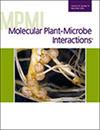Samodya K Jayasinghe, Natalia Moroz, Peiguo Yuan, Michael V Kolomiets, Kiwamu Tanaka
求助PDF
{"title":"Salicylic Acid Plays a Major Role in Potato Defense Against Powdery Scab Pathogen, <i>Spongospora subterranea</i> f. sp<i>. subterranea</i>.","authors":"Samodya K Jayasinghe, Natalia Moroz, Peiguo Yuan, Michael V Kolomiets, Kiwamu Tanaka","doi":"10.1094/MPMI-12-24-0154-R","DOIUrl":null,"url":null,"abstract":"<p><p>Potato powdery scab, caused by the soilborne pathogen <i>Spongospora subterranea</i> f. sp. <i>subterranea</i> (<i>Sss</i>), poses a significant threat to potato production, reducing potato value and impacting fresh market quality. Effective management strategies for this disease are currently lacking, and <i>Sss</i> is widespread in many potato-growing regions, highlighting the urgent need for effective control measures. Although the use of disease-resistant cultivars holds potential as a sustainable solution, the genetic mechanisms underlying resistance to <i>Sss</i> remain unclear. In this study, we investigated the role of the defense-related phytohormone salicylic acid (SA) in potato resistance to <i>Sss</i>. Initial analyses of defense gene expression revealed transcriptional reprogramming in response to <i>Sss</i> infection in potato hairy root cultures. Quantification of defense-related phytohormones further demonstrated a significant increase in SA levels in <i>Sss</i>-infected roots, whereas other phytohormones, jasmonic acid and ethylene, showed no substantial variation. Pretreatment of hairy roots with SA resulted in a marked reduction in <i>Sss</i> propagation, suggesting that SA contributes to induced resistance against the pathogen. To further elucidate the role of SA, we utilized transgenic potato hairy roots overexpressing the tomato SA receptor gene <i>SlNPR1</i> to enhance SA sensitivity or expressing the bacterial <i>nahG</i> gene to deplete endogenous SA. Our findings showed reduced <i>Sss</i> growth in <i>SlNPR1</i> overexpression lines, whereas <i>nahG</i> lines exhibited increased pathogen proliferation. These findings were further validated in fully grown potato plants using a pot assay. Collectively, our results indicate that SA plays a pivotal role in mediating resistance to powdery scab in potato. [Formula: see text] Copyright © 2025 The Author(s). This is an open access article distributed under the CC BY-NC-ND 4.0 International license.</p>","PeriodicalId":19009,"journal":{"name":"Molecular Plant-microbe Interactions","volume":" ","pages":"599-609"},"PeriodicalIF":3.4000,"publicationDate":"2025-07-01","publicationTypes":"Journal Article","fieldsOfStudy":null,"isOpenAccess":false,"openAccessPdf":"","citationCount":"0","resultStr":null,"platform":"Semanticscholar","paperid":null,"PeriodicalName":"Molecular Plant-microbe Interactions","FirstCategoryId":"99","ListUrlMain":"https://doi.org/10.1094/MPMI-12-24-0154-R","RegionNum":3,"RegionCategory":"生物学","ArticlePicture":[],"TitleCN":null,"AbstractTextCN":null,"PMCID":null,"EPubDate":"2025/6/12 0:00:00","PubModel":"Epub","JCR":"Q2","JCRName":"BIOCHEMISTRY & MOLECULAR BIOLOGY","Score":null,"Total":0}
引用次数: 0
引用
批量引用
Abstract
Potato powdery scab, caused by the soilborne pathogen Spongospora subterranea f. sp. subterranea (Sss ), poses a significant threat to potato production, reducing potato value and impacting fresh market quality. Effective management strategies for this disease are currently lacking, and Sss is widespread in many potato-growing regions, highlighting the urgent need for effective control measures. Although the use of disease-resistant cultivars holds potential as a sustainable solution, the genetic mechanisms underlying resistance to Sss remain unclear. In this study, we investigated the role of the defense-related phytohormone salicylic acid (SA) in potato resistance to Sss . Initial analyses of defense gene expression revealed transcriptional reprogramming in response to Sss infection in potato hairy root cultures. Quantification of defense-related phytohormones further demonstrated a significant increase in SA levels in Sss -infected roots, whereas other phytohormones, jasmonic acid and ethylene, showed no substantial variation. Pretreatment of hairy roots with SA resulted in a marked reduction in Sss propagation, suggesting that SA contributes to induced resistance against the pathogen. To further elucidate the role of SA, we utilized transgenic potato hairy roots overexpressing the tomato SA receptor gene SlNPR1 to enhance SA sensitivity or expressing the bacterial nahG gene to deplete endogenous SA. Our findings showed reduced Sss growth in SlNPR1 overexpression lines, whereas nahG lines exhibited increased pathogen proliferation. These findings were further validated in fully grown potato plants using a pot assay. Collectively, our results indicate that SA plays a pivotal role in mediating resistance to powdery scab in potato. [Formula: see text] Copyright © 2025 The Author(s). This is an open access article distributed under the CC BY-NC-ND 4.0 International license.
水杨酸对马铃薯粉状痂病菌地下海绵孢的防御作用
马铃薯粉痂病是由土壤传播的地下海绵孢子菌(Spongospora subteranea f. sp. subteranea, Sss)引起的马铃薯粉痂病,对马铃薯生产造成重大威胁,降低马铃薯价值,影响新鲜市场品质。目前缺乏有效的管理策略,Sss在许多马铃薯种植区普遍存在,迫切需要采取有效的控制措施。虽然抗病品种的使用可能是一种可持续的解决方案,但对Sss抗性的遗传机制尚不清楚。在本研究中,我们研究了防御相关的植物激素水杨酸(SA)在马铃薯抗Sss中的作用。防御基因表达的初步分析揭示了马铃薯毛状根培养物对Sss感染的转录重编程反应。防御相关的植物激素的定量进一步表明,sss感染根中SA水平显著增加,而其他植物激素,茉莉酸和乙烯没有明显变化。经SA预处理的毛状根显著降低了Sss的繁殖,表明SA有助于诱导对病原菌的抗性。为了进一步阐明SA的作用,我们利用过表达SA受体SlNPR1的转基因毛状根来增强SA敏感性,并表达细菌nahG基因来降解内源性SA。我们的研究结果表明,SlNPR1过表达系的Sss生长减少,而nahG系的Sss增殖增加。这些发现在盆栽试验中得到了进一步验证。综上所述,我们的研究结果表明,SA在介导马铃薯对粉痂病的抗性中起着关键作用。
本文章由计算机程序翻译,如有差异,请以英文原文为准。

 求助内容:
求助内容: 应助结果提醒方式:
应助结果提醒方式:


